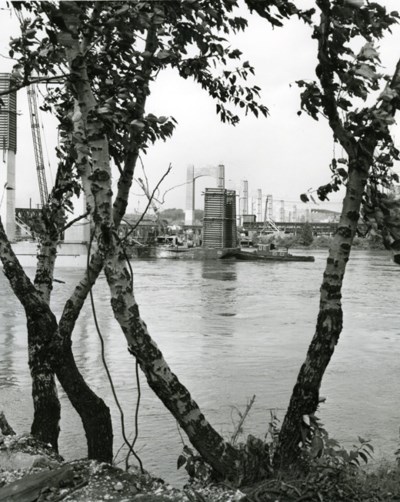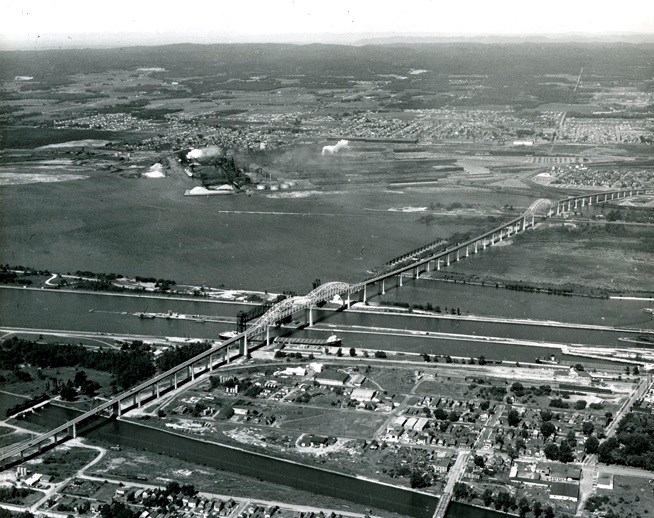From the archives of the Sault Ste. Marie Public Library:
*************************
Saultites travel across this bridge on a daily basis but prior to the 1960s the only way to cross the St. Marys River was by ferry.
The International Bridge is situated on the crossroads of two of North America’s longest highways, the I-75 and the Trans-Canada Highway making it an ideal location.
The idea to build a bridge between the twin Soo’s dates back to 1934, when a group of Sault businessmen formed the Sault Bridge Authority.
They began the process of acquiring legal permission from the Michigan government in 1935 and the U.S. Congress in 1940.
However both acts expired before anything could be done.
However this setback did not kill the idea of a bridge joining the two cities.
 From the archives the Sault Ste. Marie Public Library
From the archives the Sault Ste. Marie Public LibraryThe U.S. Federal government renewed permission in 1953, followed by the Michigan government in 1954 resulting in the International Bridge Authority Act. In 1955, Canada created the St. Mary’s River Bridge Company making it possible for an international bridge to proceed.
At this time, the Mackinac Bridge was being constructed and due to open in 1957 which would increase the flow of traffic to the Upper Peninsula, and could place more stress on the current ferry system.
In addition, the Trans-Canada Highway around northern Lake Superior was scheduled to open in 1960.
Plans for the construction of the bridge proceeded.
The International Bridge Building firm of Steinman, Boynton, Gronquist and London from New York City was selected to pick a suitable location.
Six possibilities were considered.
One of the possible locations was Sugar Island; however this was rejected because it was too far from either city.
Another option that was under consideration was a tunnel; this too was rejected due to the high construction costs.
The current location was finally agreed upon and Dr. Carl Gronquist designed a two mile bridge, from plaza to plaza with 62 piers, which would cost approximately $20 million to build.
Once the financing of the bridge was secured, the ground breaking ceremony took place on September 16, 1960.
In order to accommodate the locks and their traffic, trusses were constructed to span the canal without the use of piers being placed in the canals.
Dr. Gronquist created a four-span continuous truss over the American ship canals.
This came to be known as the “Gronquist design” since this was the first time that this was ever used in a four span construction.
The use of light weight trimmed steel was also a new innovation that was used during the construction.
This particular innovation reduced the cost of the bridge by $280,000 and saved at least 480 tons of steel.
Canadian and American construction crews worked from each side of the river and built towards each other.
Incredibly, when the two spans met, they were only 2 centimetres out of alignment!
The workers didn’t always work in the safest of conditions, often enduring extreme weather such as -34 degree Celsius temperatures and snowfall accumulation of 115.2 inches during the winter of 1962.
Their day usually began with two hours of ice and snow removal before any further work could continue on the bridge.
The bridge was built to accommodate the frequent expansion and contracting due to the temperature extremes that can be experienced between the summer and winter months.
The bridge opened in October 1962 but the official ribbon cutting ceremony was held on May 24, 1963 with both Michigan Governor George Romney and Ontario Premier John Robarts present for the ceremony.
The tolls for the bridge go towards the ongoing maintenance and the original tolls were $1.25 for a one-way fare for a passenger vehicle.
The International Bridge is not only a reminder of our ingenuity but also a symbol of the bond and cooperation that we share with our twin city.
*************************
Each week, the Sault Ste. Marie Public Library and its Archives provides SooToday readers with a glimpse of the city’s past.
Find out more of what the Public Library has to offer at www.ssmpl.ca and look for more Remember This? columns here
